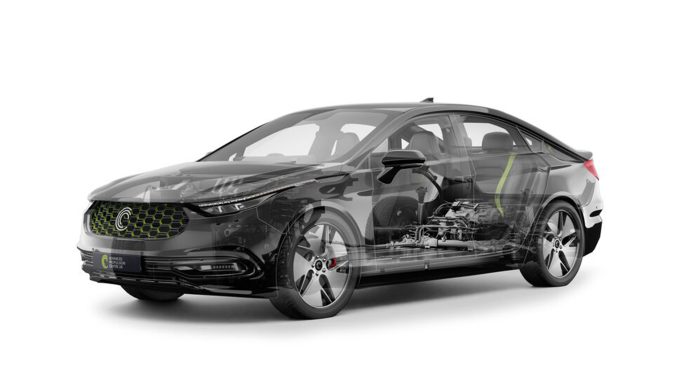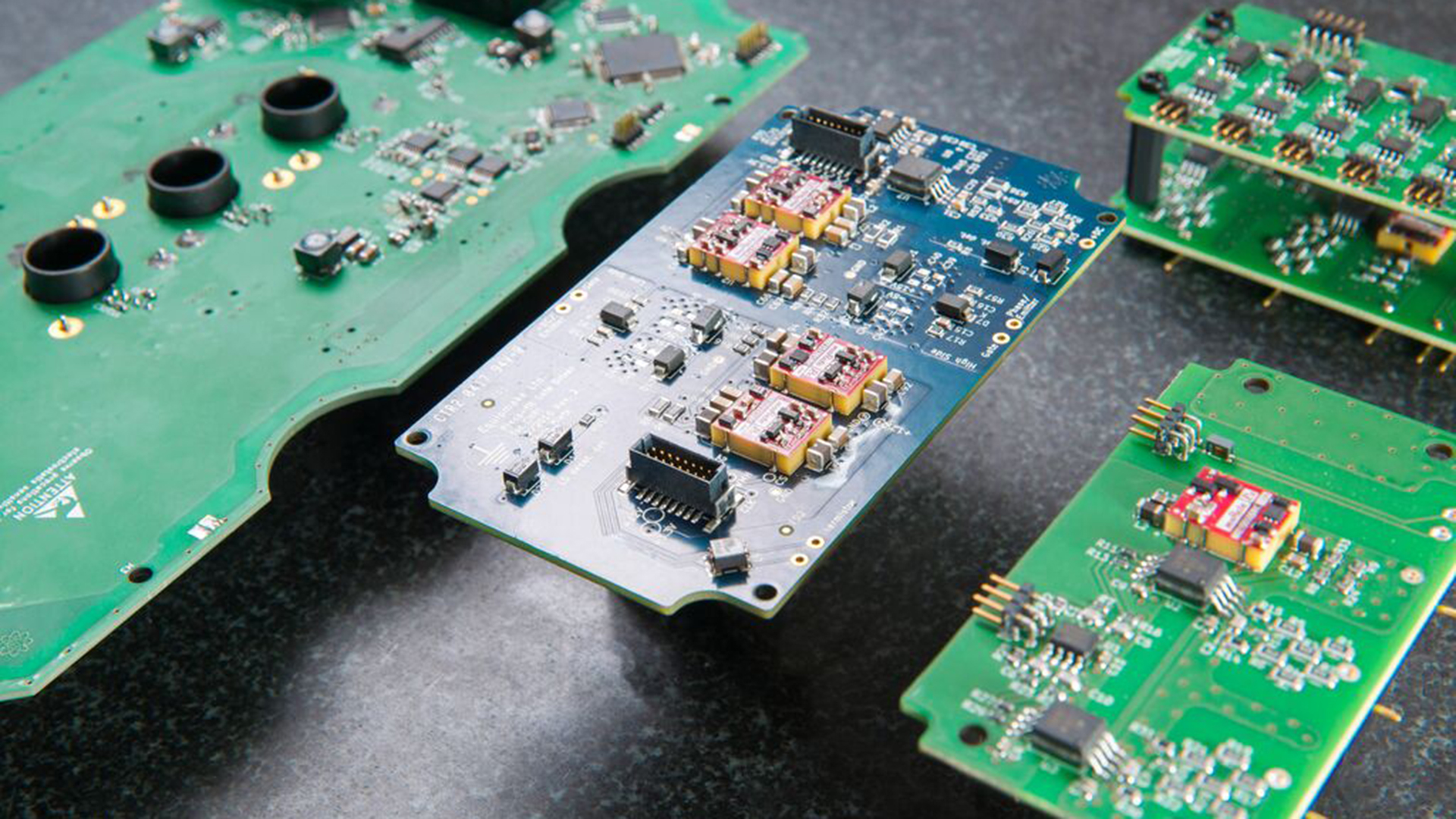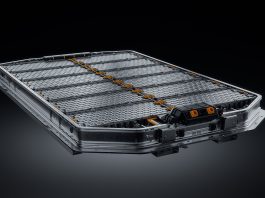Joe Dobson, Project Delivery Lead at APC, reflects on the importance and opportunities within the power electronics sector and the difference projects like ESCAPE can make to economic growth and security in the UK.
Power electronics are fundamental to electric vehicles (EVs) and undoubtedly represent key components that are central to the transition to zero-emission vehicles, and yet are a somewhat under-appreciated opportunity for innovation in the UK.
At the heart of EVs are power electronic devices which have semiconductors as one of the most important components these are commonly referred to as chips. Semiconductors are needed for a wide range of applications on vehicles, ranging from the entertainment system to power-steering. Crucially, they are an integral part of any electrified powertrain, supplying and controlling the current and voltage throughout the drive system. EVs use 30% more chips than ICE (internal combustion engine) vehicles.
The UK has world-leading expertise in the development and manufacture of silicon semiconductors and unlocking this expertise to build a supply chain for automotive power electronics in the UK is very much up for grabs.
The Advanced Propulsion Centre UK collaborates with the UK government, the automotive industry and academia to accelerate the industrialisation of technologies that support the transition to zero-emission vehicles and towards a net-zero automotive supply chain in the UK.
Through a Collaborative Research and Development (CR&D) competition, the APC has brought together a consortium of organisations to use this expertise to build a UK-based supply chain for automotive power electronics in a CR&D project called ‘ESCAPE.’
Project ESCAPE
Launched in 2019, ESCAPE was a £19.5m CR&D project that received £9.7m of grant funding from the Department for Business and Trade, which was facilitated through the APC. The partners involved brought a range of expertise across the industry and academia; they included McLaren Applied, Clas-SiC Wafer Fab Ltd, Compound Semiconductor Applications (CSA) Catapult, Exawatt, University of Warwick, Compound Semiconductor Centre Limited, Lyra Electronics Ltd, Microchip Technology Inc., Vishay Intertechnology, Inc. (previously MaxPower Semiconductor, Inc). AESIN and Turbo Power Systems (TPS).
Together, they have delivered several pioneering innovative technologies, including high-performance inverters, chargers and converters that are now ready for production.
With so many nations competing for domination in power electronics, the ESCAPE consortium decided to focus on high-performance power electronics that use compound semiconductors made from Silicon Carbide (SiC). By securing the SiC supply chain in the UK, we can foster a whole industry around a localised end-to-end supply chain, which exponentially increases UK jobs and capabilities.
SiC is a wide bandgap technology that can play a crucial role in improving efficiency in power electronics. Examples of where these technologies provide improvements include:
- Higher power-conversion efficiency relative to silicon-based power electronics
- Reduced switching losses in SiC devices enable higher switching frequencies, which allows for a reduction in the size of passive components and motors
- More efficient power conversion leads to a reduced cooling requirement
- SiC’s high dielectric breakdown electric field strength allows for simple and efficient 800V conversion system
- Built-in body diode in a SiC MOSFET (metal–oxide–semiconductor field-effect transistor) can eliminate the need for a separate anti-parallel diode
- Allows for operation at higher temperatures with reduced risk of thermal runaway
UK’s power electronics opportunity
The UK is world-renowned for innovative engineering in many fields and dominates motorsport engineering. This provides a competitive advantage in developing power electronics for EVs that will enable more power, longer ranges and faster charging.
The UK now has an opportunity to be globally competitive. When it comes to pure silicon, many other countries have taken over that landscape. However, opportunities are present in compound semiconductors such as SiC and Gallium Nitride (GaN), but we must work together and act fast. The clock is ticking.
Collaboration is key
The key to APC CR&D project success is collaboration. The ESCAPE project has brought together one of our largest consortia of partners, demonstrating the breadth and depth of the supply chain requirement in joining a consortium of universities, research organisations, manufacturers, SMEs, and Tier 1 automotive suppliers together.
The power is in numbers. With a dozen companies in the consortium, it is not just the conversations that are had throughout this project on this specific development but the ongoing conversations leading to other projects that are all going to stem from this. Collaboration has a multiplicative effect on what can be generated.
Project ESCAPE has delivered developments throughout the supply chain, from new etching and epi-layer growth techniques to innovative packaging technologies, culminating with high-performance inverters, chargers, and converters ready for manufacture.
Equally crucial are the high-value relationships, future opportunities, and large foreign direct investment in UK SiC manufacturing, including Vishay Intertechnology’s acquisition of MaxPower Semiconductor. The project has demonstrated the opportunity of having an end-to-end supply chain for automotive electrification here in the UK, and it does not have to stop there.
By onshoring this capability, the UK can reduce costs and create jobs in this growing technology field, enhancing its competitiveness and resilience for the supply chain and allowing it to access the capability locally in the global market. To maintain its position as a global leader for SiC technology in the high-performance sector, the UK needs to continue to focus on developing advanced components through projects like ESCAPE, which enables higher power output, longer range, and faster charging.
Deep dive into the powerful components
SiC MOSFETs offer huge potential for power electronic systems due to their reduced conduction and switching losses and ability to withstand higher junction temperatures.
By operating at higher switching frequencies and voltages of 800V +, SiC provides a compounding effect from improved power conversion efficiencies of 5-15% and significant weight savings to the electric motor, cabling, and cooling system.
Although SiC inverters cost more to produce than Si inverters, efficiency gains across the complete powertrain system can reduce the battery size by
3-5% (for a given range), offering a valuable route to offsetting costs and reducing critical battery material demand.
With a focus on SiC semiconductors, then the UK has a credible chance of creating an end-to-end supply chain. SiC is the preferred front-runner for future electric vehicle power distribution, control, and supply management. It is cost-effective when its benefits are applied across the powertrain system, providing power efficiency gains and reducing the size of motors and the battery pack.
Three Tier 1 components were developed as part of project ESCAPE: An inverter, a DC-DC converter, and an offboard charging station (OfBC).
- An inverter converts DC power from the vehicle’s battery to AC power to drive the electric motor. These high-power devices (30-400 kW) are either standalone or integrated with the electric motor into an electric drive unit (EDU).
- A DC-DC converter on a BEV or plug-in hybrid electric vehicle (PHEV) decreases (steps-down) voltage from the high voltage battery, e.g., 400-800 V, to low voltages as needed by the vehicle’s auxiliary systems. These are typically low-power devices (3-7 kW) but high power on a fuel cell electric vehicle (FCEV).
- An OfBC station is used to charge the vehicle. A high-power medium volt supplied ‘Hub and Spoke’ EV charging solution was developed based on a highly Innovative SiC-based 500 kW Medium (11 kV) to Low (400V) Voltage Electronic sub-station converter.
In 2023, APC released a report outlining the end-to-end manufacturing process of power electronics in EVs, with an accompanying insight report to spotlight what focus is needed to onshore an end-to-end supply chain in the UK and meet the predicted demand for 2.3 million inverters per annum for UK-manufactured passenger cars and vans.
The report concludes that increasing local SiC semiconductor and inverter production for high-power vehicles (luxury, performance, SUVs, and HGVs) will future-proof automotive manufacturing in the UK.
With 80% of the economic value held across power modules and the manufacturing of inverter systems, the UK can play to its strengths with capabilities in its domestic Tier 1 supply chain.
View the Power Electronics Value Chain and Insight report.
The UK must continue to invest in research, development, and implementation of power electronics technology.
By supporting the growth of this critical technology, the UK can ensure that its automotive sector remains competitive and sustainable in the rapidly evolving global market.
By harnessing the power of this technology, the UK can drive innovation, create new opportunities, and reduce its environmental impact. As the automotive sector continues to evolve, power electronics will play an increasingly significant role in shaping the future of transportation in the UK and beyond.
About the Advanced Propulsion Centre UK
The Advanced Propulsion Centre UK (APC) collaborates with the UK government, the automotive industry and academia to accelerate the industrialisation of technologies that support the transition to zero-emission vehicles and towards a net-zero automotive supply chain in the UK.
Established in 2013, the APC, with the backing of the UK Government’s Department for Business and Trade (DBT), has facilitated funding for 264 low-carbon and zero-emission projects involving 492 partners. Working with companies of all sizes, this funding has helped to create or safeguard over 58,000 jobs in the UK. The technologies and products that result from these projects are projected to save over 410 million tonnes of CO2.
With deep sector expertise and cutting-edge knowledge of new propulsion technologies, the APC’s role in building and advising project consortia helps projects start more quickly and deliver increased value, accelerating new technologies to market. The APC works to drive innovation and encourage collaboration, building the foundations for a successful and sustainable UK automotive industry.
In 2020, the UK Government established the Automotive Transformation Fund (ATF) to accelerate the development of a net-zero vehicle supply chain, enabling UK-based manufacturers to serve global markets. ATF investments are accessed through the APC and awarded by DBT to support strategically important UK capital and R&D investments that will enable companies involved in batteries, motors and drives, power electronics, fuel cells, and associated supply chains to anchor their future.
For more information, go to apcuk.co.uk or follow us:
@theapcuk on X and Advanced Propulsion Centre UK on LinkedIn.
Note
The term ‘safeguarded jobs’ refers to continued employment for existing roles that might otherwise be lost in some sectors rather than new jobs created.
All job and CO2 figures are cumulative forecasts and cover a ten-year range from the start of the project. A percentage ‘risk’ calculation is applied to these forecast figures to account for unknown market forces that may change how a business operates. It also ensures that we are not overstating the benefits. We adjust this weighting periodically as more analysis becomes available. All figures are subject to monthly review and may change.
Throughout the project’s lifetime, we regularly reassess and adjust the figures and apply risk methodology to the metrics in line with Department for Business and Trade guidelines.
Please note, this article will also appear in the 19th edition of our quarterly publication.










